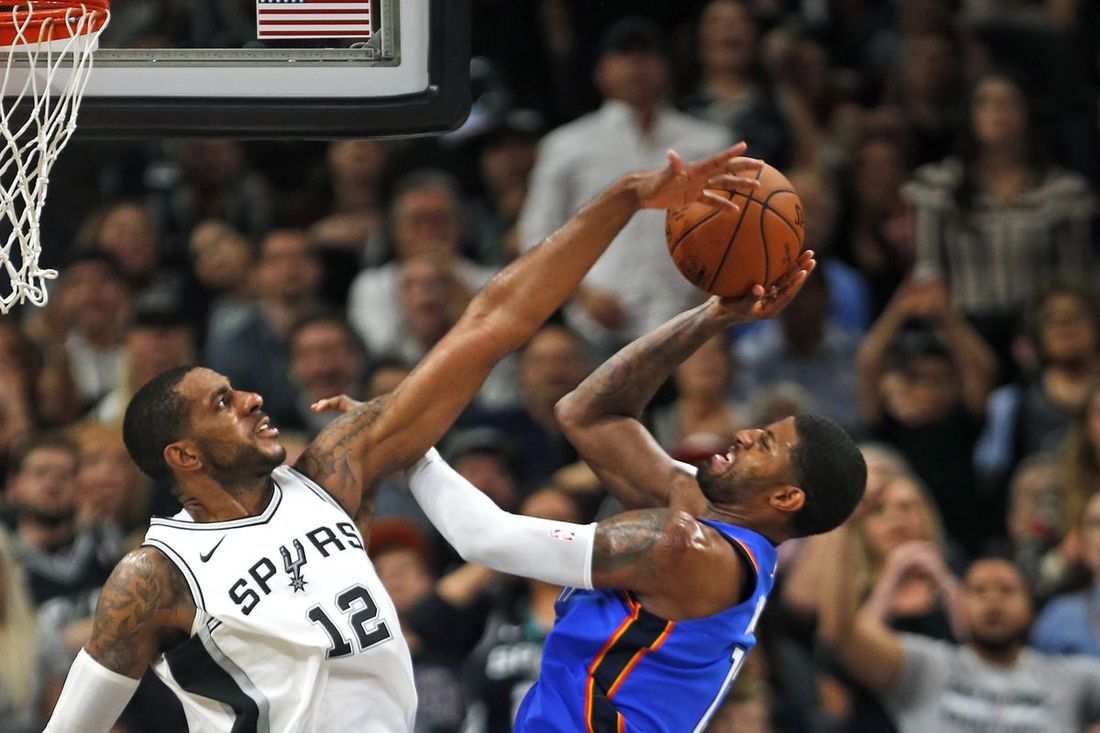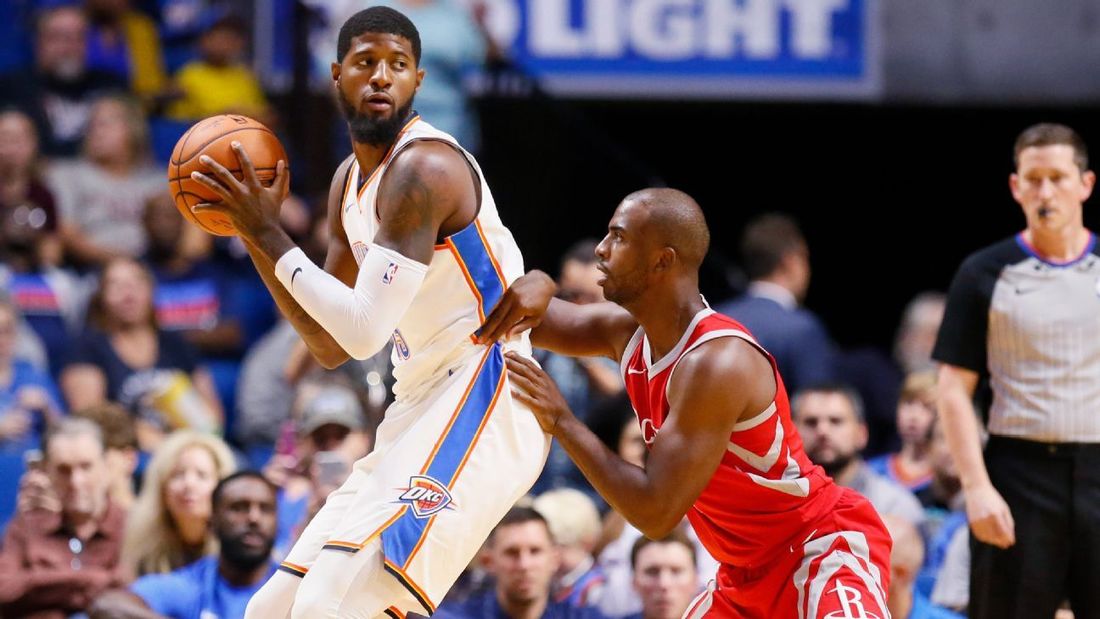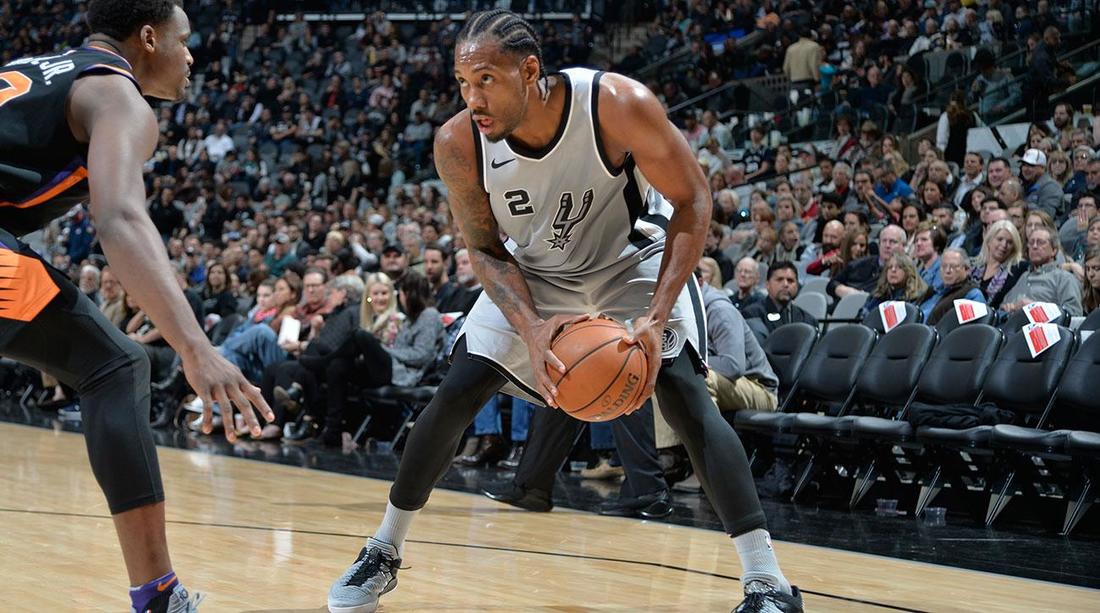|
As the eyes of many NBA fans shift towards the postseason, some front office executives are thinking about how they can improve the fates of their franchises that are not currently vying for postseason play. The pre-draft process is filled with tons of scouting, evaluation periods, internal discussion and workouts for some of the hopeful rookies that want a spot in the NBA. Taking the drafting needs and picks into consideration, financial considerations can paint the biggest picture to what decisions will be made beyond the draft. Trading some players, utilizing cap space for taking on others, and preparing for free agency all are highly informed by the team's salary situations – after all, the NBA is a business. Both the Oklahoma City Thunder and San Antonio Spurs exited the playoffs in the first-round in 2018, a disappointing finish for teams that expected postseason success. With major questions looming regarding their best players, cap situations and how to approach improvement, these are perhaps the two teams with key offseason forecasts this summer Oklahoma City Thunder 2017-18 Record: 48-34 2018 Draft Picks: 53rd, 57th (from BOS) Restricted Free Agents: none Unrestricted Free Agents: F Jerami Grant, F Josh Huestis, G/F Corey Brewer, PG Raymond Felton, C Nick Collison Other Players of Note: F Carmelo Anthony ($27.9m player option), G/F Paul George ($20.7m player option Committed Salary: $137,538,746 Luxury Tax Room: -$13,538,746 The numbers on the salary sheet are misleading, as they represent what could be the most conservative scenarios for a franchise expecting heavy tax bills. The Thunder expect Carmelo Anthony to opt into the $28 million clause in his contract to return next season, despite his overtures that he won't accept a bench role next year. Paul George on the other hand will likely decline his player option, hit the free agent market and cash in on a big payday. The numbers matter most for OKC, struggling to choose between retaining the superstar they gave up so much to acquire and the unsung role players around him and Russell Westbrook. A team with a core of Westbrook, Melo and Steven Adams isn't as explosive at the top as most NBA Playoff teams, so it seems likely that at this point the franchise is held ransom by meeting the demands of George. Will they be able to attract him back, and what is the cost of doing so? Order of Operations 1. Decide how aggressive they can be with Paul George Will the Thunder wade into the five-year max region in order to retain Paul George? That five-year max, worth approximately $176 million, would place the Thunder in an economic stranglehold. Next season alone Oklahoma City would be sitting at $147 million in player salaries with only ten guys under contract, no first-round pick and a tax bill north of $84 million. Yikes. If ownership gives the green light, they have to make the offer. However, the financial implications are deep. They'd likely tread over the $150 million mark in player salaries next season, then get a little relief next summer when Carmelo Anthony's albatross deal comes off the books. But with nearly $120 million in committed salaries for the 2019-20 season after a Paul George deal is signed, it doesn't give the Thunder a clear avenue to replace his production or realistically dodge the luxury tax again. The other option here is something similar to the Chris Paul trade from last year: George opts in solely with the intention of being traded, gets to choose his destination of teams that don't have cap space, and the Thunder eat matching salary back to make the deal work. It's a fairly implausible scenario, simply because OKC wouldn't get much immediate tax relief next year and George isn't likely to want to take the $12 million pay cut next year to opt in. This would be a plausible scenario if his desired destination is a cap-saddled place like Cleveland, however many teams that have been preparing for a push at George (the Lakers and Sixers) can clear the necessary cap space without engaging in a deal with Oklahoma City. At the end of the day, NBA franchises are unique investments: there are times when spending too much money and going into the red is a better course of action than trimming now to get into the green. It's not for us to decide which course ownership in OKC should take, but the severe cap mismanagement and backfire of the Carmelo deal are hurting the Thunder now. 2. Jerami Grant: the casualty of being in the tax Because the Thunder are simply too expensive, it's impossible to say that it is a good idea for the team to go into the luxury tax threshold to keep Jerami Grant. The tax penalty for retaining him on a $9 million annual contract would, for next year, be more than five-times as costly. Grant is an important piece with his defensive acumen and something resembling three-point shooting ability at times -- he's almost a better player right now than Carmelo. However, Grant will be targeted heavily on the free agent market, and the Thunder don't have the chops to pay north of $40 million in tax penalties to retain a bench piece. It's safer for the Thunder to just replace him on the minimum. 3. Trimming more salary Oklahoma City could try and clear a little more cap room by expediting departures for overpaid bench players like Kyle Singler, Patrick Patterson or Alex Abrines. In a vacuum, Abrines has value on the trade market, as some team might want to take a stab at his shooting prowess in the backcourt. Abrines would likely be flipped to a team with a little cap space or a traded player exception, such as Indiana, Toronto, Chicago or Phoenix. Singler or Patterson likely need to have a second-round pick attached to them, and both of OKC's picks in 2018, in the 50s of the second-round, likely aren't enough to pawn them off elsewhere. The Thunder can trade any of their future second-rounders, but those might be cheap ways in the future to dodge the tax when they're finally looking to get underneath it. 4. Is OKC an attractive destination for the Veteran Minimum crowd? Realistically the Thunder need to get multiple role players out of their veteran minimum contracts this year. The tax bill is such that, even if Paul George leaves, OKC will have only their Mid-Level Exception to replace him with a starter, and the bench has to be filled out this way. But most veterans, or at least the good ones who know they'll be on this type of contract, want to go to a place where a championship is a possibility, organizational harmony exists and there is a lack of toxicity. I'm not sure if Oklahoma City sounds like that place. Would some of the better, more versatile pieces like Richard Jefferson, Arron Afflalo or Amir Johnson really choose Oklahoma City over other suitors? Trying to build a team via the bargain bin is much more difficult in a year where the entire league is also doing so due to a lack of free agency money available. Everything here is just poor timing for the Thunder. 5. The Mid-Level or Josh Huestis At the end of the day, OKC might have a decision to make between treading the tax waters next year to retain Josh Huestis or utilizing their MLE to add a piece on the wings. The thought of losing three of their best defenders in George, Grant and Huestis is a tough pill to swallow for the organization. While Huestis hasn't developed on offense the way they'd hope, his Bird rights dictate that OKC might be best-served giving him a shot on a one-year deal worth slightly more than the minimum, then readdressing the situation a season from now when their long-term cap is more clear. At the very least it allows them to increase his value for a mid-season trade, as some other team might covet his Bird rights if he plays well. That might be the best way for the Thunder to increase their on-court production in the short-term while not bogging themselves down with a multi-year contract with the MLE. San Antonio Spurs
2017-18 Record: 47-35 2018 Draft Picks: 18th, 49th Restricted Free Agents: F Kyle Anderson, F/C Davis Bertans, G Bryn Forbes Unrestricted Free Agents: PG Tony Parker Other Players of Note: SG Danny Green ($10m player option), F Rudy Gay ($8.8m player option), F/C Joffrey Lauvergne ($1.65m player option), SG Brandon Paul (non-guaranteed contract) Committed Salary: $101,128,770 Luxury Tax Room: $20.9m San Antonio's 2017-18 campaign was as strange as one we can ever remember from the Popovich-era Spurs. With reports surfacing about discord between the usually pristinely-run franchise and their star player Kawhi Leonard, Kawhi ended up sitting most of the year due to injury concerns. The relationship has grown contentious, leading to a worrisome question for San Antonio: will their best player and one of the top stars in the league force his way out of town? It's the linchpin for all questions Spurs right now, although neither path provides certainty that San Antonio will get some form of superstar production next year. Some questionable contracts handed out last summer inhibit the team's ability to make major moves on the market without giving away Leonard. Order of Operations 1. Lay everything on the table with Kawhi San Antonio GM R.C. Buford and coach Gregg Popovich would be wise to bring in Leonard and lay out everything in front of him so that Kawhi makes the ultimate decision. On one hand, the Spurs are the only team that can offer him a mega-max deal worth north of $200 million. Leonard would be foolish to walk away from that type of extension if it is offered, considering the questionable nature of his leg injury this year. By asking Kawhi if his intention is to stay and seek that contract, San Antonio can remove the rumored trade demands from the surface once and for all, then proceed to build around a super-maxed Kawhi. That is, if they're comfortable offering it. The other way that conversation goes is if Kawhi does ask to leave, wanting a change of scenery and a new organization. If he's willing to sacrifice that much money, Kawhi instantly becomes the most valuable trade chip in the league. Leonard has two years at just over $20 million annually left on his deal, though he can opt out again next summer (not counting a 15 percent trade kicker, which would bring the deal to about $23 million). Because of league rules regarding extensions, any acquiring team wouldn't be able to extend him up to the max contract level, so Leonard would be likely to exercise his opt-out for next summer and cash in on the extension then. Still, getting his Bird Rights is insanely valuable, and that's what the Spurs would be charging for in any trade Ultimately, if I were in charge of the Spurs, I wouldn't force Kawhi's hand in any way. If he wants a trade, give it to him now and cash out while his value is still somewhat high. If he wants to work on repairing the relationship with the intent of getting that max contract in the future, the Spurs should be all in on embracing that. 2. Player Options The key to the Spurs' summer no matter what Kawhi does hangs in the hands of Danny Green and Rudy Gay. Green, who holds a $10 million player option, is unlikely to recoup that type of money elsewhere. Gay, with an $8.8 million player option, could be sought after for roughly the same price, while he's also unable to be retained by the Spurs for more money than the Mid-Level Exception if he opts out. Regardless of what they do, San Antonio will certainly act as an over-the-cap team due to the large cap holds of Danny Green and unrestricted free agent Tony Parker... there's not incentive for the team to ask Green to opt out so they can have the cap space, sign a new free agent and then re-sign Green. At this point, the Spurs, who have always been creative with how they manufacture cap space, don't have much of an option to do so this summer. Getting guys like Danny Green and Rudy Gay back would help them go into free agency with an idea of what positions of need they'll have. My guess: both of them, and big man Joffrey Lauvergne, exercise their player options and return. 3. Trust in the draft process This is the first time in over 20 years that the Spurs will have their own draft selection higher than 20th overall. Let that soak in for a second... There's a legitimate chance here that they can find an immediate impact player, and someone that helps the team move the needle forward to get back atop the Western Conference, even with an ancient roster. San Antonio has a lot of different ways it could go: another versatile and switchy player on the wings, a more mobile big man, or even an offensive-centric shooter. Based on what the Spurs have been evolving towards in order to keep up with the likes of Golden State and Houston, a versatile wing makes the most sense. Potential targets include Ohio State's Keita Bates-Diop, Khyri Thomas of Creighton, Boise State's Chandler Hutchison, Donte DiVincenzo of Villanova, Oregon's Troy Brown or Cincinnati's Jacob Evans. Perhaps my favorite fit for the Spurs though: Lonnie Walker, the long and lanky smooth scoring guard from Miami. If he somehow falls to the Spurs at 18th, they should rejoice, as the backcourt pairing of Dejounte Murray and Lonnie Walker is one to celebrate. 4. Mid-Level Exception & Bi-Annual Exception targets San Antonio is one of the few teams in the league that is likely to utilize their Bi-Annual Exception. The reason: they can retain their own free agents and remain far enough below the luxury tax to use both the full $8.8 million of the Mid-Level Exception and the $3.4 million of the Bi-Annual. That would be, though, assuming that both Green and Gay opt in, Anderson takes a team-friendly deal as an RFA, and they don't have much roster change with a Kawhi trade. San Antonio's most pressing needs on their roster involve shooting -- playing Aldridge at the 4 and Dejounte Murray as the starting point guard means spacing often gets cramped in the Alamo city. Would the MLE be enough to lure in a guy like Avery Bradley or Kentavious Caldwell-Pope? Other more reach candidates include Joe Harris and Wayne Ellington. That that $3.4 million Bi-Annual exception, San Antonio should be able to snag a good player at slightly below market value. It's a great year to use the Bi-Annual because many teams will only have the veteran minimum level deals to offer guys that fall through the cracks of the MLE. What about adding another frontcourt depth piece like Nemanja Bjelicia, Trevor Booker or Channing Frye? 5. Timing Ginobili decision, pricing of Parker There's little to anticipate with these guys: both will be back in San Antonio if both want to play next season. The question becomes if Ginobili will retire and how little of a salary Parker, who has perennially been underpaid, will accept. The timing of the communication between the two sides is key. For Parker, the Spurs don't want to overpay a point guard that will likely once again be coming off the bench for them. For Manu, the Spurs would benefit from hearing about Manu earlier in free agency, that way they have an extra $2.5 million to use before the market starts to dry up. The sooner the Spurs understand what it'll take to get these guys, the better off they'll be with negotiating their restricted free agents to ensure they avoid the tax. Add around $8 million for those three players and $8.8 from the Mid-Level Exception again and the Spurs are only a couple mill against the luxury tax. Every dollar matters here.
0 Comments
Leave a Reply. |
Adam SpinellaHead Boys Basketball Coach, Boys' Latin School (MD). Archives
September 2021
Categories |



 RSS Feed
RSS Feed
